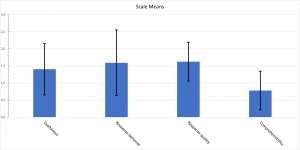Development and Evaluation of voice-assisted bladder training for elderly care, based on healthcare professionals and nursing students – a mixed method study
Aim and Research Question(s)
The aim of this thesis was the development of a prototype to support healthcare employees which resulted in the following research questions:
(1) How does the UX of a voice assisted bladder training, based on a prototype voice application for smart speaker and evaluated by the standardized UEQ plus and additional open questions compare to default bladder drill?
(2) In addition to the typical standards for a clinical trial, which obstacles must be considered when conducting a trial on voice-assisted bladder drill in nursing homes?
Background
Urinary incontinence (UI) is a highly prevalent condition ranging from 25% to 45% in women [1]. This does not only cause psychological issues for the affected but also poses an high economic burden for individuals and health insurance companies [2]. Professional nursing can provide beneficial effects on the treatment of UI [3]. These healthcare professionals can be supported by voice assistants, however the use in this setting is still sparse compared to other domains [4].
Methods
Literature including information on UI such as a treatment and different types had to be gathered. Additionally, research on voice assistants and health literacy had to be collected for the different features of the prototype. After the collection of data, the Alexa skill was developed with an online visual programming tool called Voiceflow. The evaluation used a mixed method approach in the setting of a experts group combining both qualitatively data gathered with open questions and quantitatively data in form of a UX questionnaire.
Results and Discussion
The experts formulated that the developed tool cannot be used on people suffering from hearing-, speech-, or cognitive-impairedness. Additionally, the stationary nature of smart speakers is a disadvantage. However, a combination with wearables such as a smart watch would greatly improve the experience. The quantitatively evaluation has shown a positive result for the scales “Usefulness“, “Response behavior” and “Response quality”. Furthermore, a neutral result for “Comprehensibility“ has been achieved.

Conclusion
After further improvement of the prototype into a high-fidelity condition, a trial should be conducted to compare the effect of voice-assisted bladder drill with conventional bladder training. Possible participants are residents of nursing homes but also people still living at home (whether they receive care or not). The participants have to be properly assessed first to exclude specific types of UI (such as stress UI or urinary tract infection).
References
[1] 10.1080/13697137.2018.1543263
[2] 10.1053/j.gastro.2003.10.056
[3] “Harninkontinenz bei geriatrischen Patienten, Diagnostik und Therapie”, Arbeitsgemeinschaft der Wissenschaftlichen Medizinischen Fachgesellschaften e.V.
[4] 10.1093/jamia/ocy072